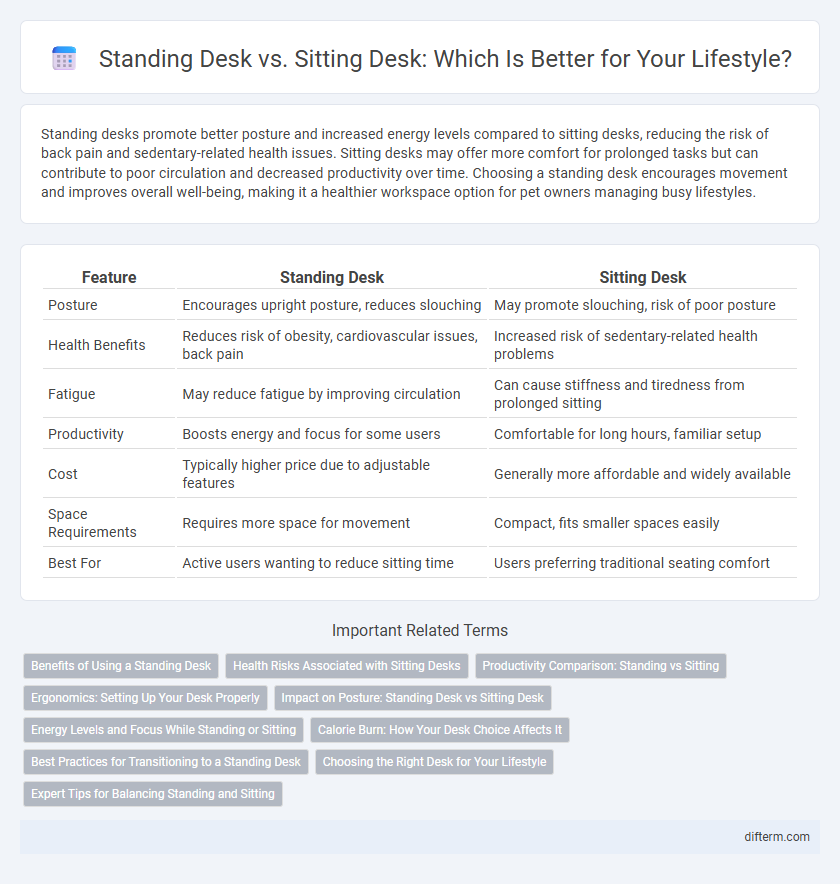Standing desks promote better posture and increased energy levels compared to sitting desks, reducing the risk of back pain and sedentary-related health issues. Sitting desks may offer more comfort for prolonged tasks but can contribute to poor circulation and decreased productivity over time. Choosing a standing desk encourages movement and improves overall well-being, making it a healthier workspace option for pet owners managing busy lifestyles.
Table of Comparison
| Feature | Standing Desk | Sitting Desk |
|---|---|---|
| Posture | Encourages upright posture, reduces slouching | May promote slouching, risk of poor posture |
| Health Benefits | Reduces risk of obesity, cardiovascular issues, back pain | Increased risk of sedentary-related health problems |
| Fatigue | May reduce fatigue by improving circulation | Can cause stiffness and tiredness from prolonged sitting |
| Productivity | Boosts energy and focus for some users | Comfortable for long hours, familiar setup |
| Cost | Typically higher price due to adjustable features | Generally more affordable and widely available |
| Space Requirements | Requires more space for movement | Compact, fits smaller spaces easily |
| Best For | Active users wanting to reduce sitting time | Users preferring traditional seating comfort |
Benefits of Using a Standing Desk
Using a standing desk improves posture and reduces the risk of chronic conditions such as cardiovascular disease and obesity by promoting movement throughout the day. Studies show that standing desks can enhance energy levels and boost productivity by minimizing fatigue and discomfort associated with prolonged sitting. Incorporating a standing desk into your workspace also helps increase calorie expenditure, supporting weight management and overall health.
Health Risks Associated with Sitting Desks
Prolonged use of sitting desks significantly increases the risk of cardiovascular disease, obesity, and type 2 diabetes due to reduced physical activity and poor posture. Sedentary behavior associated with sitting desks can lead to musculoskeletal disorders, including lower back pain and neck strain. Incorporating standing desks reduces these health risks by promoting movement and improving circulation throughout the day.
Productivity Comparison: Standing vs Sitting
Standing desks enhance productivity by promoting increased blood flow and reducing fatigue, leading to improved focus and energy levels throughout the workday. Sitting desks, while comfortable for extended periods, may contribute to decreased alertness and slower cognitive function due to reduced physical activity. Studies show that alternating between standing and sitting can optimize productivity by balancing comfort and movement.
Ergonomics: Setting Up Your Desk Properly
Proper ergonomic setup of a standing desk involves adjusting the height so that your elbows form a 90-degree angle and your monitor is at eye level to reduce neck strain. For sitting desks, maintaining a chair with lumbar support and positioning feet flat on the floor helps prevent back pain and promotes good posture. Using an adjustable desk with ergonomic accessories like footrests and keyboard trays enhances comfort and reduces the risk of musculoskeletal disorders.
Impact on Posture: Standing Desk vs Sitting Desk
Standing desks promote better posture by encouraging a neutral spine alignment and reducing slouching compared to sitting desks, which often lead to prolonged poor posture and increased risk of musculoskeletal issues. Ergonomic standing desks with adjustable height options allow users to alternate between sitting and standing, minimizing strain on the lower back and reducing the likelihood of developing chronic pain. Research indicates that using standing desks can significantly decrease neck and shoulder discomfort, improving overall spinal health and workplace productivity.
Energy Levels and Focus While Standing or Sitting
Standing desks enhance energy levels by promoting better blood circulation and reducing fatigue compared to sitting desks, which often lead to sluggishness and decreased alertness. Users report improved focus and cognitive function when alternating between standing and sitting, as standing encourages more active engagement and prevents the monotony associated with prolonged sitting. Incorporating adjustable desks that allow seamless transitions supports sustained energy and mental clarity throughout the workday.
Calorie Burn: How Your Desk Choice Affects It
Standing desks can increase calorie burn by approximately 88 calories per hour compared to sitting desks, promoting better weight management and metabolic health. Prolonged sitting is linked to lower energy expenditure, contributing to weight gain and metabolic issues over time. Choosing a standing desk encourages more movement and muscle engagement, enhancing overall daily calorie expenditure and supporting an active lifestyle.
Best Practices for Transitioning to a Standing Desk
When transitioning to a standing desk, start by gradually increasing standing intervals to avoid fatigue and promote comfort. Incorporate anti-fatigue mats and supportive footwear to reduce strain on joints and muscles. Maintain ergonomic posture by adjusting desk height to elbow level and keeping monitors at eye level to prevent neck and back pain.
Choosing the Right Desk for Your Lifestyle
Choosing the right desk for your lifestyle depends on balancing ergonomics and daily activity levels; standing desks promote better posture and increase calorie expenditure, while sitting desks support longer focus periods with less physical fatigue. Adjustable desks offer the most flexibility by allowing seamless transitions between sitting and standing, accommodating varying work tasks and personal comfort. Prioritize desk height, surface size, and mobility features to match your workspace and enhance productivity effectively.
Expert Tips for Balancing Standing and Sitting
Experts recommend alternating between standing and sitting every 30 to 60 minutes to reduce muscle strain and improve circulation. Ergonomic adjustments, such as using anti-fatigue mats and adjustable desk heights, enhance comfort and prevent posture-related issues. Incorporating movement breaks and maintaining a neutral spine alignment are essential for long-term musculoskeletal health.
Standing Desk vs Sitting Desk Infographic

 difterm.com
difterm.com